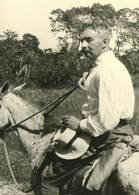Americanist, editor and translator of Nahuatl texts. Born in Berlin (Preußen, Germany) 16 September 1878, died in Berlin (Germany) 7 February 1939. After receiving a M.D., Lehmann joined the Berlin Ethnographical Museum in 1903 as "Volontär" in the American Department; he also pursued Americanistics at the university under the tutorship of Eduard Seler [1849-1922]. He was sent to Central America by the Museum, where he concluded a linguistic survey from 1907/09. Upon his return he was appointed curator at the Ethnographical Museum in München and received a Ph.D. in 1913 and a Habilitation in 1915 from the university there, both with studies of Central American Indian languages and linguistics ("Vokabular der Ramasprache.." and "Über die Stellung und Verwandtschaft der Subtiaba-Sprache..").
In 1920 Lehmann returned to the Berlin Museum as head of a recently created "Forschungs- und Lehrinstitut", and, later was also appointed director of the American, Oceanic and African Collections, which gave him the power to overrule decisions of the departmental curators. On his second and third field trips to Latin America (1925/26 and 1929/30) he continued his linguistic survey and extended it to Andean South America, collected extensively portable artifacts from excavations and dealers, copied ancient American stone sculpture and mural paintings, and collected manuscripts and rare books. It was his untyring spirit as a collector which finally resulted in the most comprehensive and valuable private document and book collection on Indian America assembled during the 20th century in Germany. This collection is completely preserved at the Iberoamerikanisches Institut (Berlin).
After his last field trip Lehmann was active as university teacher and organizer of two great exhibits on Amercian and Oceanic art in Berlin. In 1934 he had to relinquish all posts under Nazi reorganization laws ("zur Vereinfachung der Verwaltung") but was permitted to continue his personal research at the Iberoamerikanisches Institut, then headed by General Wilhelm Faupel. There he inaugurated a series of documentary publications ("Quellenwerke zur alten Geschichte Amerikas, aufgezeichnet in den Sprachen der Eingeborenen") which where to contain his editions and translations of Nahuatl sources. To date thirteen book size monographs have been published in this series, four of which contain material translated by Lehmann but edited posthumously by Gerdt Kutscher and [1913-1979] and Günter Vollmer [born 1937].
Lehmann's studies of Central American languages and linguistic classification, where the first successful effort to cover this important intermediate region. It still stands with their classification into language groups and their external genetic relationships to Mesoamerican and south American language families. Lehmann, himself however considered the disentangling of Central Mexican cultural chronology the most challenging problem. By taking the written indigeneous sources as historical documents and by analyzing their chronologies, he made important progress in defining the Toltecs as a historical tribe of the Late Classic and Early Postclassic times. After his death, archaeology did much to refine his so-called "Toltekenfrage". In his days he was also very successful as a popularizer of American Indian art through two widely read books (Altmexikanische Kunstgeschichte... and Kunstgeschichte des alten Peru...) and the aformentioned exhibition. Lehmann's importance for modern research lies mainly in his editorial endavors. In Germany his impact is mostly felt through his library and collections around which an Anthropological Research Department at the Iberoamerikanisches Institut was built.
(Text by courtesy of Berthold Riese; photo source: http://portal.iai.spk-berlin.de/Walter-Lehmann.204.0.html)



